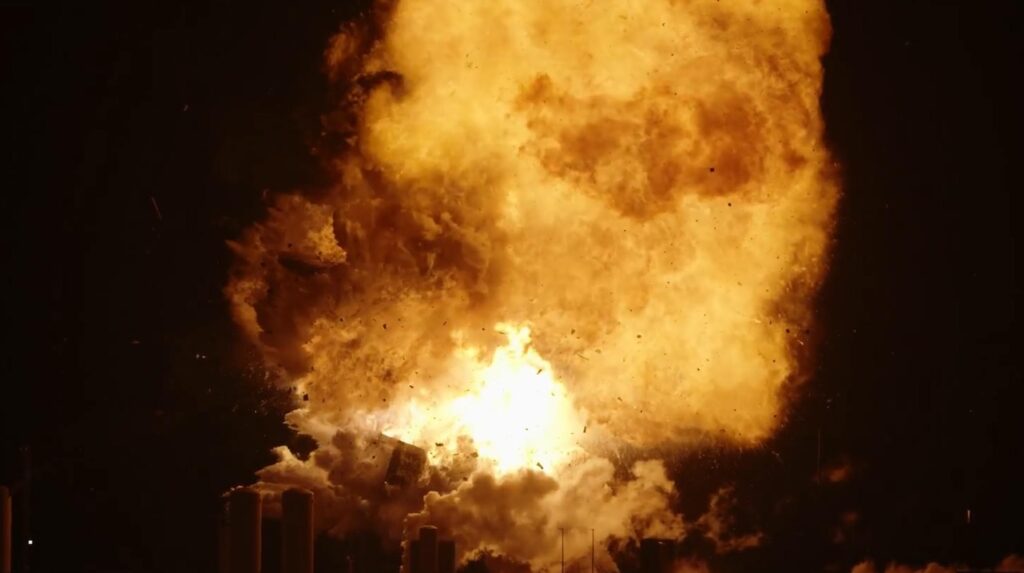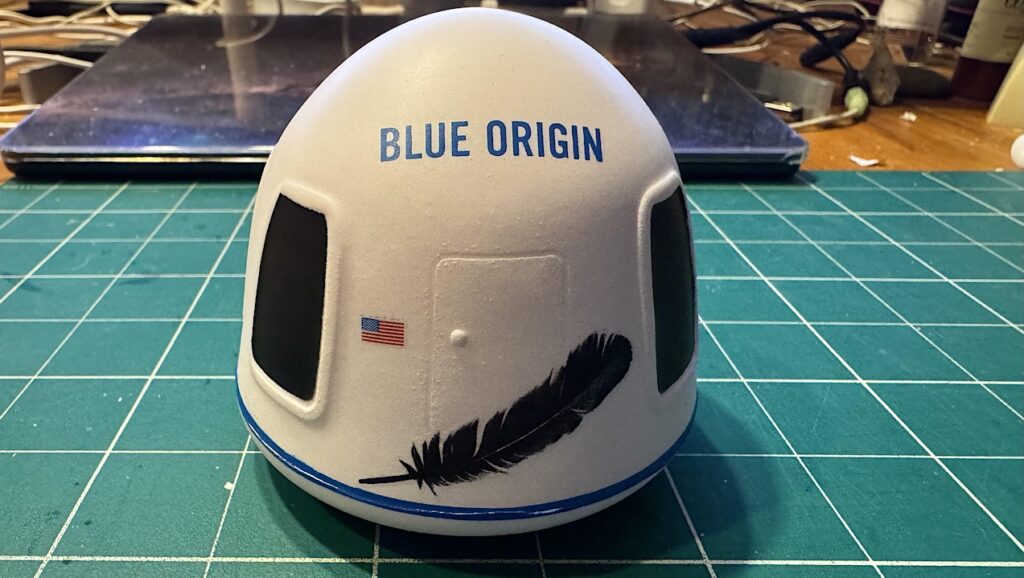The Future Is Here, Y'all
SpaceX Starship SN8 from an aerial ?#spacex #BocaChica ????
When do you think we might see it's maiden flight, first week of November? @elonmusk https://t.co/WBrLbKExB7 (10/23, 2200ft msl) pic.twitter.com/IJb9RBIfFn— RGVAerialPhotography (@RGVaerialphotos) October 23, 2020









I hope architecture doesn’t go with the retro look too. Art Deco was always a bit over the top.
Welcome to the Gernsback Continuum.
I follow what they’re doing in Boca China closely, and am rooting for them, but yeah, not a big fan of the current looks. I was an Aerospace engineer in a former life, and it makes me wonder if they have top flight (no pun) aerodynamicists at SpaceX…
Based on observing SX past performance, I’d predict that anything not performing will be modified or changed into something that does perform. Nowhere is it more true that form follows function.
That being said, I wonder what you see in that design that’s troubling?
Art Deco’s predictive reach into the future is finally coming to fruition.
One of my concerns is that the current Starship design precludes the ability to have any kind of an in-flight abort system. Some have said that “Starship is the abort system”, which reminds me of the Titanic “the ship is the life boat”. Although I suspect the Starship design will be radically different by time it is crew-rated.
Of course that was the same case with the Shuttle Orbiter which was never flight tested to the same extent. And true with every airliner. It is also probably why Elon Musk says it will make hundreds of flights before humans are flown.
“And true with every airliner.” … what does this mean. Every design is statically tested during certification, and analyzed 16ways to Sunday. Every article has production flight test to ensure that it is working as expected.
I’m not sure about that. What do you mean by an abort system? If it’s something to get the vehicle containing the crew (and passengers) away from something which is in the process of failing catastrophically, the Starship has an abort system. The second stage (unfortunately also called Starship by SpaceX) can get away safely from a problem with the first stage (called SuperHeavy.)
But if you mean an abort system to get the crew and passengers away from the vehicle they are actually in, I don’t think any spacecraft has every had one. There is nothing to get the crew of a Soyuz away from a failing Soyuz capsule, or the people on a Dragon 2 away from a failing Dragon 2. Nor was that true of Orion, Apollo, etc. And, in the case of Apollo, the Command and Service Module did have enough propellent and propulsion to make it dangerous if something had gone wrong with a main engine firing.
I think that in the spirit of aerospace speak, and since it is made out of Stainless Steel, that SpaceX should name the combined Starship/Super Heavy the Reusable Aerospace Transport (RAT).
I am sure that James Bolivar deGriz would approve.?
I think that the issue is getting the crew away from big tanks of propellant and high-force engines. Starships have both hence the question of how crew would survive a failing Starship.
I’d say the engines and propellent tanks in the Apollo service module were big enough to be a serious threat to the crew, had anything gone badly wrong. Once an explosion is big enough, it doesn’t really matter how big it is. Apollo had no abort system for an explosion of the CSM propellent tanks. (Or even a small explosion in the SM; saving the crew of Apollo 13 was improvisation, not process planned for in advance.)
Saying that a capsule can in some scenarios fail and kill the crew doesn’t change the argument that overall a capsule with a parachute is safer than other types of vehicles during launch and landing, at least with current technology. If the failure is in the booster stages and the capsule can get away, the crew will likely survive. Even if the abort system fails and the booster explodes beneath the capsule, there is a chance the capsule will remain intact and the crew will survive. If the Shuttle somehow had a crew capsule incorporated into the body of the vehicle (not that it would have been practical with that design) the Challenger and Columbia crews may very well have survived the atmospheric breakup of those vehicles. Challenger especially since they think the crew possibly survived until water impact. With Columbia it would have depended on how long it took the escape capsule to orient itself with the heat shield facing in the right direction.
As I don’t know the mass of the crew cabin on Challenger, I can’t say how much of a payload penalty would have been incurred for a parachute recovery system or the cabin. Although not intended to, the cabin did separate from the fuselage of the orbiter. IIRC, each SRB after propellant burnout weighed about 170,000 lbs on water impact. We recovered them with three 136 ft dia. mains and a drogue chute that probably weighed about 10,000 lbs total.
As far as airliner being thoroughly tested, can you say British Comet or B737MAX?!!
But…I told Wilbur and I told Orville and I’m telling you…it’ll never get off the ground!
The requirements that the Shuttle designers had to deal with were onerous enough that to also include an escape capsule, which would have impacted payload capacity and probably crew size, not to mention prolonging development, would have been out of the question. Especially in an environment where many people were beginning to believe that spaceflight had become routine, to the point of being comfortable with astronauts launching without pressure suits, not having any abort capability in the first two minutes, and limited abort capability after that depending on the scenario and when it occurred.
After Challenger that thinking quickly reversed as many began to realize in hindsight that astronauts should go to space in smaller, safer vehicles designed solely for that purpose. The Shuttle meanwhile could have been used solely as an automated returnable cargo vehicle, a role that I think it would have been more suited for, and much more capable than the proposed Shuttle-C, which was essentially a wingless orbiter which did not have return cargo capability and was not reusable. An uncrewed Shuttle would have also allowed the program to maintain a higher flight rate and thus ultimately lower overall cost per flight, assuming that it was regularly used as a satellite launcher which was part of its original mandate.
As excited as I am about Starship I see it as what will most likely be a fantastic cargo ship to and from Earth orbit (and beyond). But only carrying passengers after they have reached orbit by some other method, then taking them to their destination. For that role it will be well suited because there will likely not be significantly safer alternatives, whereas I think for carrying humans to and from Earth orbit there will be safer alternatives. Modifying Robert Heinlein a bit, once you have safely reached Earth orbit, you are halfway to anywhere in the solar system.
I think the problem (or confusion) here is that Starship is _both_ the second stage _and_ the orbital spacecraft. Starship/SuperHeavy does have an abort system if something goes wrong with the booster: If SuperHeavy fails, immediately firing the engines on Starship would get it clear and it would then land on its own (no parachute required.) If something on Starship (the second stage and orbital vehicle) fails, then the passengers would be in the same situation as the crew of an Apollo command and service module if there had been a catastrophic problem with SM’s main engines or propellent tanks. There’s no way around that if the same hardware contains both a primary propulsion system and the orbital “capsule”.
Agreed regarding Super Heavy failure, contingent however on Starship getting safely away from Super Heavy in time. But you likely lose the possibility of survival in a scenario where Starship is still attached to or is still too close to Super Heavy when things go wrong, as Starship has a higher possibility of being damaged in a way that will render it incapable of a safe landing. Or if it becomes momentarily unstable during the event and turns sideways from the direction of travel and undergoes stresses beyond what it is capable of and breaks up. I know Starship is designed to fall practically broadside on the way down through the atmosphere, but it does that in a certain orientation (belly facing down). In an out of control situation it may not necessarily maintain structural integrity at all angles and at all speeds. A capsule generally has a better chance of maintaining structural integrity when it gets tossed sideways into a high speed airflow. As long as the capsule stays relatively intact and as long as the parachute functions the crew will likely survive. It doesn’t need to even maintain cabin pressure as long as the crew are wearing pressure suits. I tend to doubt that Starship passengers will all be wearing pressure suits during launch and landing, but I don’t really know maybe they will.
But then we come back to Starship also functioning as the second stage, with catastrophic failure of the second stage being unsurvivable.
Of course a capsule effectively acts as a third stage, at least its service module does, but that is after it reaches orbit. And orbital propulsion is generally of much lower magnitude and complexity compared to booster engines. Combined with the overall greater structural robustness of a capsule, the likelihood of a catastrophic failure that would damage the capsule enough that it couldn’t survive reentry and landing is much lower.
Speaking of abort systems, I was thinking about discussions of abort systems by Everyday Astronaut and Scott Manley on those for various systems. There were many scenarios which the tower might not have helped, Gemini ejection seats firing from a 100% O2 cabin, lack of abort on Shuttle. But Soyuz abort systems actually has saved crews before. I’d still require something that is able to pull crew cabin from a failing rocket. Perhaps overall design and implementation be similar to transatlantic air transport, put the effort on aircraft and flight plans to tolerant problems when over the ocean. Don’t plan for ejection seats, extreme temperature survival suits, etc. An overall design challenge, early design planning quite important. Don’t select a concept that becomes a black hole of constant disaster mitigating (and where costs keep going up an up and up). I was thinking not many of us are in a position to make those choices.
“One of my concerns is that the current Starship design precludes the ability to have any kind of an in-flight abort system.”
Just like every airliner and most aircraft. The idea is not to remove all risk, just make it a reasonable risk for the particular operation.
Airliners have fatal accidents at the rate of about one crash for every 3,000,000 flights. How soon do you think spacecraft will reach even one tenth of that level (one fatal accident per 300,000 flights). How long until they are “only” one hundred times more dangerous than an airliner (one fatal accident per 30,000 flights). I can see a short term goal (say ten years) where flying to orbit is one thousand times more dangerous than flying on an airliner (one fatal accident per 3,000 flights).
Even at that level, if the “particular operation” as you refer to it is carrying workers or ordinary fare paying passengers to orbit and beyond, that is not a reasonable risk that most people will accept. Only the bold and brave accept that risk, which is how anyone who currently flies to space should be regarded.
The difference between an airliner and an orbital space vehicle is night and day in terms of risk and will be for decades in my opinion. Airliners fly in a much less dynamic environment using propulsion and fuel systems that are under much less stress. Also airline flights are measured in the tens of thousands per day, pre-Covid it was over 100,000 commercial flights per day. Design or maintenance problems show up relatively quickly in that huge data pool, which also allows corrections and mitigations to be verified quickly.
Rocket launches meanwhile are around one hundred per year. And currently human spaceflight is close to nil. Even assuming that human spaceflight increases in this decade there will still be more airliners taking off every minute (approximately 70) than a year’s worth of human orbital spaceflights. Every rocket launch is essentially a test flight and will remain so for at least a couple of decades in my opinion.
Yes, the DH Dragon Rapide was ugly but did it’s job so well they built over 700 in the early 1930’s. It was basically Britain’s Tri-Motor during that era.
A biplane, and they may return in the form of the box wing.
https://droider.ru/wp-conte…
Agreed that they will iterate as needed. The front end just seems a bit sketchy to me… Most of it is just gut feel, but the rotation axis of the front flap seems suboptimal. Also to reduce heating I’d think you’d want as large a surface area as possible… But there is likely a weight tradeoff. Of course we don’t know what trades they were looking at. I imagine mostly they’re trying to minimize construction cost… also just before posting I did a quick google and they have an opening for aerodynamicists 😉
The forward and rear aerial surfaces are not for flight control. They are for braking by drag.
AIUI. The Starship is mostly a brick with attitude control during most of flight profile from orbit back to the ground. Except for the flare pull up just before landing by thrust vectoring with the Raptors.
“The forward and rear aerial surfaces are not for flight control. They are for braking by drag.”
Yes I understood… just that if they have a forward component of the velocity vector, it seems like there will be some unwanted coupling… could be wrong, or maybe they actually want that.
During the Skydiver entry/descent maneuver differential drag adjustments using the flaps can induce roll, pitch and yaw, but in no way are they working like conventional wings, fins or flaps. More like a skydiver using his arms & legs to adjust his attitude & rate of descent.
https://youtu.be/fRdoP1sJP_s
The Falcon 9 was only 1 year old when SLS program was started, and SLS is a derivative of existing hardware.
The falcon 9 is reusable and has been now for years, and the second major SpaceX rocket with reusability is already on the pad readying for a test flight. It’s really too bad that NASA and Boeing can’t get the SLS flying anytime soon, or with any reasonable expenditures of funds.
Exactly! It seems that Space X represents the future and everything else just represents corporate welfare that has kept humans from going out of low earth orbit since 1973.
I have no doubt that they will be able to take off and land the thing vertically.
That ‘belly flop and hover slam” transition and landing maneuver that will be used for the suborbital flight testing is where the rubber meets the road.
Yes, and it also where the limitations of the Boca Chica location will become apparent if it digs a hole over the border in Mexico or hits one of the buildings there.
Hence it launches over the Gulf not over land.
But it does it’s landing maneuver over . . . land.
Think the initial landing point is way offshore with transition back inshore to the landing pad after the Starship is pitched vertical from horizontal with the powered flare pull up.
Failure to correctly pitch up vertically will just add an artificial reef offshore.
That depends upon the mode of failure: total (which would build your reef) or partial (loss of control mid “swoop”).
Yes, but SpaceX has been using a landing procedure at the Cape that keeps the returning boosters off-shore as long as possible until they translate to the landings pads. Musk has said they do this to minimize any risk of a crash on land.
Looking at Boca Chica and the surroundings and doing some measurement, it looks like the shortest distance to Mexico from the landing pads at Boca Chica is about 2.4 miles give or take a bit. The Gulf of Mexico is on the order of 2000 feet away to the East, and it looks like there is a bay just on the other side of Boca Chica Blvd, about 300-400 feet away from the landing area.
It really seems like the risk of crashing in Mexico is very small. Assuming that they launch over the Gulf, things would have go really pear shaped to get Starship SN8 to crash in Mexico.
I am not talking about an death arrow from above; unlike the Falcon 9 landing Starship is going to do a belly-flop decel with a hoverslam landing.
That is where I see the potential danger. I am pretty sure that SpaceX has figured out how to get the sticks back from the edge of space.
I don’t really see an International hazard here, though. That kind of snuck into the thread.
It is always there when you operate close to the border. And it wouldn’t be the first time. Besides the famous WSMR V2/A4 incident in 1947 there were two other rockets, IRBM’s that landed in Mexico as well although those were in the 1960’s.
There was a Russian bird that sprayed radioactive materials over Canada as well.
That was a fairly different issue. It was a non-operational spacecraft which had been in orbit for years. It reentered and its fragments landed in Canada. The Soviets couldn’t control where it was going to crash. (Although, by modern standards, they should have commanded a planned deorbit over somewhere in the middle of no where, like the deepest or most isolated parts of the Pacific Ocean. And done so before there was any real chance the satellite would die before they could command a targeted reentry.) Once they left it up until it failed, the Soviets had no control over where it would come down. Which is sloppy and reckless, but not something they could had control of after the satellite failed.
In this case, we’re talking about accidents in the course of a launch or a planned landing. That’s all known in advance, and while the vehicle is operating. The people in charge have the freedom to avoid flying over inhabited places, where the vehicle could crash should something goes wrong. Overflying inhabited areas during launch or a planned landing is both reckless _and_ within the control of the people in charge.
Don’t forget South Padre Island to the north which will limit the flight path, nor the small fishing boats normally offshore. The U.S. Coast Guard is going to need to put out a notice to keep them away, and as the Dragon2 Crew mission shows, actually enforce it.
Also don’t forget the international boundary extends out into the Gulf of Mexico.
Possibly, but unlike Falcon 9, a Starship should be able to hover (see the SN5 & SN6 flights), so it could do its kick-up maneuver over water or marsh and then translate over to the launch pad.
“That ‘belly flop and hover slam” transition and landing maneuver that
will be used for the suborbital flight testing is where the rubber meets
the road.”
Agreed, but if they fail they have other Starships ready to go after they make improvements. I expect Starship to fail several times, but I also expect Space X to quickly move on.
What progress has been made since the last Shuttle Mission to make manned spaceflight more accommodating for truly commercial use? If cost reduction is the most obvious improvement, can’t most important space benefits be derived by robotic missions? Hal to Dave: “This mission is too important for me to allow you to jeopardize it.”
What’s everyone’s guess as to when Starship will make a manned, orbital flight with a crew of 25?
“What progress has been made since the last Shuttle Mission to make manned spaceflight more accommodating for truly commercial use?”
1.) It got through the wringer that the Chair of the Senate Appropriations Committee (SAC) demanded NASA put it through by:
A.) Meeting the requirements above and beyond either what Space Shuttle ever met, or what Orion/SLS will ever have required of it.
B.) Doing it without the money the SAC moved from Commercial Crew to SLS for the first 5 years of Commercial Crew.
“If cost reduction is the most obvious improvement, can’t most important space benefits be derived by robotic missions?”
Not the basic benefit of human spaceflight, which Congress cannot bear to have mentioned in front of the Press. That being, human settlement of the Solar System. Science alone is *not* the only priority for spaceflight, and for many, it is not the highest priority. Even this disregards the enormous flood of data that will become available from a site once a human settlement supporting scientific and technical work is established in any interesting place. Of course, this will do nothing to assure budgets for supporting grad student theses being written from the data, as the presently structured “mission” framework does. “Data, Data everywhere, and not a dollar to analyze it with!” Hmmmm, … too hard to come up with the rest of the rhyming parody, but you get the idea.
” What’s everyone’s guess as to when Starship will make a manned, orbital flight with a crew of 25?”
That sounds like a checkout flight for a first crewed landing of the Lunar Lander variant. That variant would have no re-entry capability, however, so you could call it the first ferry mission for Artemis. I’d call that, at the current rates of progress, for 2025, early or late.
Sooner than SLS.
SLS gets a real beating on this site, for all of the obvious reasons. However, I would point out that very large amounts of hardware for SLS are actually complete – more than probably many are aware. Check out Tim Dodd.
This is in now way an apology for SLS; only getting the facts about completion, not cost.
https://www.youtube.com/wat…
WORMWATCH ALERT! Keith, check out the new Lunar Starship mock-up coming together at Boca Chica. Complete with white paint and a red worm logo.